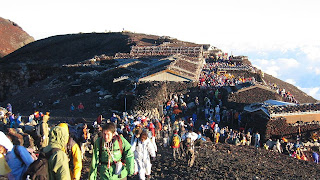Standing at a staggering 12, 389 feet, Mount Fuji, located on the Honshu Island, wins the title as the highest mountain in Japan. Besides it's height, the mountain is also loved and recognized for its impossibly symmetrical peak and breathtakingly beautiful snow caps. Because of this aesthetically pleasing uniqueness, the mountain is often the center of many art pieces and photographs. It is also the destination of thousands of eager tourists from around the world.
In addition to being deemed one of Japan's Three Holy Mountains (alongside Mount Tate and Mount Haku), on June 22 2013, Mount Fuji was also added to the World Heritage List as a Cultural Site. This recognition has had many positive components to it, such as increased national pride and tourism, but it has also contributed to a rising problem Japan has been dealing with regarding the preservation of the mountain's natural beauty. With the curiosity of thousands of tourists comes a price for the environment, such as mounting trash, poor air quality, and constant "suburban sprawl".
Though overwhelmingly grateful about the recognition, it is hard for the Japanese people not to feel some concern over whether the popularity this title has sparked will ultimately lead to the destruction of what made a national landmark in the first place. Officials have made countless efforts to improve and maintain the quality of the environment without reducing traffic of tourists. Low-waste toilets have been installed on various points on the mountain, hybrid buses shuttle the visitors to the trails, and thousands of volunteers work to pick up trash left behind by tourists. An additional effort has recently been put in place this summer where climbers are asked to pay a fee, which will all be donated towards the effort to preserve the natural beauty Mount Fuji has to offer.
When asked about his opinion on the matter, the head of Whole Earth Nature School, Keisuke Tanaka, says that donations should be used to "improve trails and toilets and add
waste treatment facilities and multilingual signs." He also believes the government should step in and begin to limit the number of people allowed to visit the landmark.
Since making the cut for the World Heritage list, more and more measures are being taken to make sure people are treating this place with respect and care. New guidelines have been released stating that hikers must submit their plans in writing and are required to carry the proper equipment at all times. This is not only to protect the environment, but also to keep people safe!
It is crucial for people to work together towards the preservation of the beautiful nature Mount Fuji and other international landmarks have to offer!




No comments:
Post a Comment